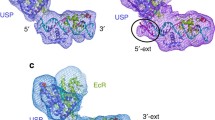Abstract
Steroid hormone recepTo Whom It May Concern:rs belong to a family of nuclear receptors that trigger transcriptional activation of target genes by specific binding to DNA recognition sequences, usually located in the 5'-flanking region of the target gene. Nuclear receptors appear to be segmented proteins1 and extensive structure-function analyses have attempted to elucidate the functional significance of individual segments. Two of these regions have been defined as the domains responsible for recognition of responsive elements of target genes (region C) and hormone binding (region E) (refs 2–7). But the functional significance of the N-terminal region (A/B), which diverges extensively even for a given receptor between different species, has remained obscure. We have previously cloned, expressed and analysed the chicken progesterone receptor (cPR) (ref. 8). This receptor and its human homologue from T47D breast cancer cells are unique among the steroid hormone receptors in that two forms, A and B, are present in equal amounts in cytosolic extracts, the latter having the higher molecular weight9,10. For the chicken progesterone receptor, we have presented evidence suggesting that the cPR form A corresponds to an N-terminally truncated form of B (ref. 8). Here we report on the functional difference between the forms A and B in the transcriptional activation of two target genes.
Similar content being viewed by others
References
Green, S. & Chambon, P. Nature 324, 18–25 (1986).
Green, S. & Chambon, P. Nature 325, 75–78 (1987).
Kumar, V., Green, S., Stack, G., Berry, M., Jin, J. R. & Chambon, P. Cell 51, 941–951 (1987).
Kumar, V., Green, S., Staub, A. & Chambon, P. EMBO J. 5, 2231–2236 (1986).
Hollenberg, S. M., Giguère, V., Segui, P. & Evans, R. M. Cell 49, 39–46 (1987).
Godowski, P. J., Rusconi, S., Miesfeld, R. & Yamamoto, K. R. Nature 325, 365–368 (1987).
Danielson, M., Northrop, J. P. & Ringold, G. M. EMBO J. 5, 2513–2522 (1986).
Gronemeyer, H. et al. EMBO J. 6, 3985–3994 (1987).
Gronemeyer, H., Harry, P. & Chambon, P. FEBS Lett. 156, 287–292 (1983).
Wei, L. L. et al. Biochemistry 26, 6262–6272 (1987).
Gannon, F. et al. Nature 278, 428–434 (1979).
Zenke, M. et al. EMBO J. 5, 387–397 (1986).
Green, S. et al. Nature 320, 134–139 (1986).
Renkawitz, R., Schütz, G., von der Ahe, D. & Beato, M. Cell 37, 503–510 (1984).
von der Ahe, D., Renoir, J. M., Buchou, T., Baulieu, E. E. & Beato, M. Proc. natn. Acad. Sci. U.S.A. 83, 2817–2821 (1986).
Gope, M. L. et al. Nucleic Acids Res. 15, 3595–3607 (1987).
Bailly, A., Le Page, C., Rauch, M. & Milgrom, E. EMBO J. 5, 3235–3241 (1986).
Hollenberg, S. M., Giguere, V., Segui, P. & Evans, R. M. Cell 49, 39–46 (1987).
Miesfeld, R., Godowski, P. J., Maler, B. A. & Yamamoto, K. R. Science 236, 423–427 (1987).
Jeltsch, J. M. et al. Proc. natn. Acad. Sci. U.S.A. 83, 5424–5428 (1986).
Weinberger, C. et al. Nature 324, 18–25 (1986).
Thompson, C. C., Weinberger, C., Lebo, R. & Evans, R. M. Science 237, 1610–1614 (1987).
Benbrook, D. & Pfahl, M. Science 238, 788–791 (1987).
Petkovich, M., Brand, N. J., Krust, A. & Chambon, P. Nature 330, 444–450 (1987).
Giguere, V., Ong, E. S., Segui, P. & Evans, R. M. Nature 330, 624–629 (1987).
Brand, N. et al. Nature (in the press).
Tooze, J. Molecular Biology of Tumor Viruses 2nd Edn, Part 2 (Cold Spring Harbor Laboratory Press, 1982).
Dierich, A., Gaub, M. P., Le Pennec, J. P., Astinotti, D. & Chambon, P. EMBO J. 6, 2305–2312 (1987).
Cato, A. C. B., Henderson, D. & Ponta, H. EMBO J. 6, 363–368 (1987).
Banerji, J., Olson, L. & Schaffner, W. Cell 33, 729–740 (1983).
Gorman, C. M., Moffat, L. F. & Howard, B. H. Mol. cell. Biol. 2, 1044–1051 (1982).
Author information
Authors and Affiliations
Rights and permissions
About this article
Cite this article
Tora, L., Gronemeyer, H., Turcotte, B. et al. The N-terminal region of the chicken progesterone receptor specifies target gene activation. Nature 333, 185–188 (1988). https://doi.org/10.1038/333185a0
Received:
Accepted:
Issue Date:
DOI: https://doi.org/10.1038/333185a0
- Springer Nature Limited
This article is cited by
-
Dienogest increases the progesterone receptor isoform B/A ratio in patients with ovarian endometriosis
Journal of Ovarian Research (2012)
-
The role of steroids in follicular growth
Reproductive Biology and Endocrinology (2006)
-
17beta-estradiol suppresses TLR3-induced cytokine and chemokine production in endometrial epithelial cells
Reproductive Biology and Endocrinology (2005)
-
MAP kinase/estrogen receptor cross-talk enhances estrogen-mediated signaling and tumor growth but does not confer tamoxifen resistance
Oncogene (2002)





